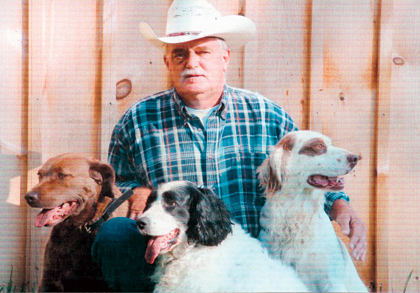The latest training techniques for pointing breeds, retrievers and spaniels.
By James B. Spencer
 Doug Deats |
"I started hunting and training dogs so long ago," Doug said, "that, well, back then, the Dead Sea wasn't even sick yet! Those years have convinced me that you gotta use a lot of shoe leather to shoot enough wild birds to turn a just-trained bird dog into a first-class hunting partner. There's just no substitute for wild birds, and lots of them."
Doug feels that the most common mistake owners make is thinking they can jump-start a just-trained dog's hunting career by buying and plant-ing 20 or so pen-raised birds for him to find and point. But birds that don't fly well and are planted too close together can undo a lot of training very quickly.
Young dogs especially need wild birds, and in great abundance. Doug has hunted all over the country, north, south, east, and west, and says he's never found an area where he couldn't work his dogs on wild birds if he put in the time and effort to find such places.
He emphasized that you should never shoot a bird your dog hasn't pointed. Nor should you allow a hunting buddy to do so. Let the wild flushes get away. And above all, don't shoot any bird your dog bumps, whether accidentally or deliberately.
Doug believes a good hunting bird dog should be steady. Otherwise the hunt becomes a circus, with the dog getting in the way so you can't shoot, or flushing distant birds while chasing pointed ones, and so on.
To keep your dog steady, you should never approach him on point from the rear. Always swing wide and come in from his side, so he can see you and read your body language. Then, too, you shouldn't let him retrieve every shot bird.
"During your dog's first season," Doug said, "you should retrieve about half the birds you shoot over his points. That'll convince him he won't get to retrieve every bird, which makes staying steady much easier for him. If all goes well, by the end of his first season, you might be retrieving only one out of three birds. I always retrieve the easy falls and send my dog only for the tough ones."
Doug insists that you should never hunt with more than one buddy. A larger group is bad for your dog and won't put any more birds in front of him. Also, getting permission to hunt on any farmer's land is easier if there are only two of you.
"If you want a crowd, go to the mall!" he said. "If you want to impress a bunch of your friends, get a trophy wife, not a bird dog!"
If your hunting buddy has a dog, you should make sure that both dogs are rock-steady and will honor each other's points and retrieves. To assure yourself of these things, you two should train together during the off-season. And, of course, when hunting a brace, each owner should handle only his own dog, never his buddy's.
Doug concluded with the following bit of hard-earned wisdom: "Dogs are always in training, even when hunting. Many dogs get the picture easily and get better and better. But some need re-training after every lunch break!"
POINTING BREEDS
This tip is from Doug Deats of The Kennels at Mill Creek Farm, 4025 County Line Road, Kent Store, VA 23084; (804) 241-2021; website www.thekennelsatmillcreekfarm.com; e-mail mllcrkfrm@aol.com. Doug has been training professionally for over 40 years. He trains pointing breeds, spaniels, and a few retrievers. He mostly trains hunting dogs, but has participated in hunt tests. He breeds an occasional litter of Brittanys, Llewellin setters and German wirehaired pointers.






